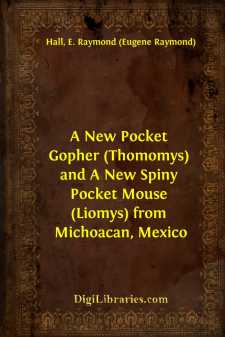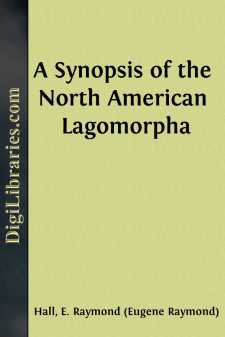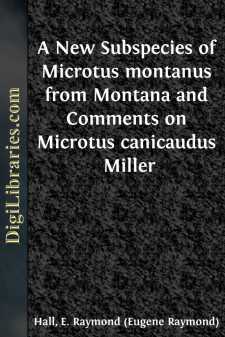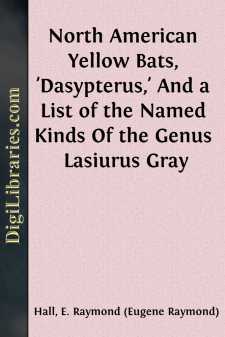Categories
- Antiques & Collectibles 13
- Architecture 36
- Art 48
- Bibles 22
- Biography & Autobiography 813
- Body, Mind & Spirit 141
- Business & Economics 28
- Children's Books 12
- Children's Fiction 9
- Computers 4
- Cooking 94
- Crafts & Hobbies 4
- Drama 346
- Education 46
- Family & Relationships 57
- Fiction 11826
- Games 19
- Gardening 17
- Health & Fitness 34
- History 1377
- House & Home 1
- Humor 147
- Juvenile Fiction 1873
- Juvenile Nonfiction 202
- Language Arts & Disciplines 88
- Law 16
- Literary Collections 686
- Literary Criticism 179
- Mathematics 13
- Medical 41
- Music 40
- Nature 179
- Non-Classifiable 1768
- Performing Arts 7
- Periodicals 1453
- Philosophy 64
- Photography 2
- Poetry 896
- Political Science 203
- Psychology 42
- Reference 154
- Religion 513
- Science 126
- Self-Help 83
- Social Science 81
- Sports & Recreation 34
- Study Aids 3
- Technology & Engineering 59
- Transportation 23
- Travel 463
- True Crime 29
A New Pocket Gopher (Thomomys) and A New Spiny Pocket Mouse (Liomys) from Michoacan, Mexico
Categories:
Description:
Excerpt
A series of 17 pocket gophers of the species Thomomys umbrinus obtained in 1943 from points 3, 4 and 5 miles south of Pátzcuaro proves upon comparison to be an hitherto unrecognized subspecies which is described and named as follows:
Thomomys umbrinus pullus, new subspecies
Type.—Male, adult, skin and skull; No. 100151, Univ. California Mus. Vert. Zool.; 5 mi. S Pátzcuaro, 7800 ft., Michoacán, Mexico; March 10, 1943; obtained by Hubert H. Hall, original No. 117.
Range.—Known only from 3 to 5 miles south of Pátzcuaro, Michoacán.
Diagnosis.—Size small (see measurements); color black or between Cinnamon-Brown and Snuff Brown; distal half of tail whitish and all of tail whitish in one specimen; lambdoidal crests perpendicular to sagittal plane of skull; posteroventral face of tympanic bulla rugose; jugal vertical (flat surface not oblique); interpterygoid space truncate at apex with sides curved outward (see figure).
Comparison.—From topotypes of Thomomys umbrinus supernus Nelson and Goldman, pullus differs as follows: More individuals wholly black (except distal half of tail); underparts lacking white; rostrum broader; braincase anteriorly slightly more expanded dorsally; lambdoidal crests perpendicular to sagittal plane rather than inclined posteromediad; interparietal broader, ââ¢â 5.7 (5.0-7.0) versus 4.5, and in ââ¢â¬ 6.5 (5.6-7.1) rather than 4.8 (4.4-5.1); flattened middle part of jugal vertical rather than oblique; in side view, mastoid and paroccipital processes farther apart thus exposing larger surface of mastoidal bulla; incisors, in both upper and lower jaws, slightly narrower; molariform teeth smaller, interpterygoid space truncate, at apex, with sides convex mediad, rather than V-shaped; ventral face of tympanic bullae rugose in posterior half rather than smooth.
Figs. 1-3.Three views of the skull of the type specimen ofThomomys umbrinus pullus. × 1.Remarks.—Among named subspecies of Thomomys umbrinus, T. u. pullus most closely resembles T. u. supernus, the subspecies next adjacent to the northward. Therefore, the results of comparisons with only that subspecies are here reported upon. T. u. tolucae to the eastward is for one thing a much larger animal and has slightly less procumbent upper incisors. So far as we know, Thomomys umbrinus has not heretofore been reported from Michoacán. Of our seventeen skins, eight are brown, six are black and two are intermediate in color.
Most of these pocket gophers lived where there was a good growth of pine trees in the same areas where large pocket gophers of the species Cratogeomys gymnurus occurred. The field notes of the collector of the type of T. u. pullus record that when he was making a shallow excavation to reveal the gopher burrow in which he trapped the holotype, he found the burrow approximately five inches below the surface of the ground and that in digging deeper than was necessary he accidentally broke into the burrow of a Cratogeomys. Another member of our field party (E. R. Hall) when removing from its burrow a trapped Thomomys that was caught only by the hind leg, dug around the animal whose burrow was approximately six inches underground and in doing so he also broke through the roof of a burrow of Cratogeomys....












